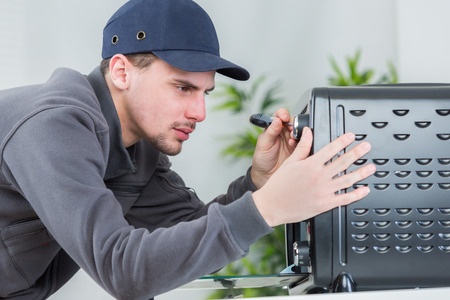 The range, stove, or oven that you use in your kitchen is the lifeline of your kitchen. Whenever there is a problem with them, it becomes difficult to complete our household chores. At times, these residential appliances may not start or may become too hot. Working with a home appliance that becomes too hot can endanger the life of your loved ones. Ideally, you should call a qualified oven service technician to service or repair the appliance. However, if you do not know a good oven technician in your area, you could attempt oven repair without getting professional help. To repair an appliance, you must first identify the part that is responsible for the problem. Once you identify the part, you must take steps to repair or replace the part. If you plan to buy the damaged part without getting help from a range repairman, you must know the model number of your machine.
The range, stove, or oven that you use in your kitchen is the lifeline of your kitchen. Whenever there is a problem with them, it becomes difficult to complete our household chores. At times, these residential appliances may not start or may become too hot. Working with a home appliance that becomes too hot can endanger the life of your loved ones. Ideally, you should call a qualified oven service technician to service or repair the appliance. However, if you do not know a good oven technician in your area, you could attempt oven repair without getting professional help. To repair an appliance, you must first identify the part that is responsible for the problem. Once you identify the part, you must take steps to repair or replace the part. If you plan to buy the damaged part without getting help from a range repairman, you must know the model number of your machine.
Here are details of some of the parts that can make the cooking appliance too hot:
Temperature Sensor
On most modern ranges, the temperature sensor is responsible for monitoring the temperature of the oven. When the temperature inside the machine becomes too hot, it signals the electronic control to turn off the element. If there is a problem with the temperature sensor, it will not be able to send any signals to the electronic controls. This may be the reason why the house appliance is producing excessive or no heat. The temperature sensor of the machine is usually located near the machine’s broil element. Most modern cooking appliances will display a fault code when there is a problem with the temperature sensor. If you believe that the temperature sensor is malfunctioning, you can check the resistance of the sensor using a multi-meter. However, you must know the correct resistance of the sensor at room temperature to make this check. Before you perform this test, make sure you remove the power supply to the appliance.
Oven Control Thermostat
 This part is usually located in the main control panel of the appliance and it controls the functioning of the broil and bake element. The thermostat is the temperature control switch of the oven, which has contacts that supply power to the elements. When there is a problem with the thermostat, the oven will produce too much, too little or no heat at all. If you notice that there is no heat or excessive heat inside the oven, then the thermostat could be at fault. Before you check the condition of the thermostat, make sure you check the condition of all other components that could be responsible for the problem. Some machine controls can be calibrated by up to 50 degree Fahrenheit, however, to do so, you will need an accurate thermometer.
This part is usually located in the main control panel of the appliance and it controls the functioning of the broil and bake element. The thermostat is the temperature control switch of the oven, which has contacts that supply power to the elements. When there is a problem with the thermostat, the oven will produce too much, too little or no heat at all. If you notice that there is no heat or excessive heat inside the oven, then the thermostat could be at fault. Before you check the condition of the thermostat, make sure you check the condition of all other components that could be responsible for the problem. Some machine controls can be calibrated by up to 50 degree Fahrenheit, however, to do so, you will need an accurate thermometer.
The adjustment screw is usually located behind the controls. However, this screw is sealed to prevent unnecessary recalibration. Before you recalibrate the temperature of the oven, you must cut the power supply to the machine. If the broil or bake element is not receiving any power supply, you must check the appropriate contacts for continuity using a multi-meter.
We Provide In Home Appliance Service In These Popular Cities:
Jacksonville FL, Orlando, Miami, Henderson, Charlotte, Indianapolis, San Jose, Richmond, Jackson, Chicago, Portland, Aurora, Olympia, Houston, Lakewood, Providence, Eugene, Manchester, Allentown, Salt Lake City, Cleveland, Everett, Fort Worth, San Francisco, Silver Spring, Detroit, Seattle, Pittsburgh, Philadelphia, Phoenix, Columbus, Oklahoma City, Dallas, Los Angeles, Atlanta, Tacoma, Baltimore, Boston, Provo, Sacramento, Louisville, Nashville, Baton Rouge, St. Louis, Raleigh, Tucson, Portland, Austin, Colorado Springs, Kansas City, Albuquerque, Virginia Beach, New York City, Middletown, Milwaukee, Las Vegas, Billings, Tampa, New Haven, Tallahassee, Denver, San Diego, Charleston SC, Little Rock, San Antonio, Birmingham, Reno City, Newark, Columbia, Omaha, Bowie, Minneapolis
The post How To Fix An Oven That’s Too Hot appeared first on OnSite Appliance
It explains how issues with the temperature sensor and thermostat can cause excessive heat. Using a multi-meter to check resistance and continuity is helpful for troubleshooting. Understanding these components is crucial in appliance repair to avoid further complications.
ReplyDeleteProper oven maintenance is essential to prevent overheating. Checking the thermostat or temperature sensor can help identify if it’s misreading, which may cause the oven to get too hot. Ensuring vents are clear and cookware does not block air circulation helps maintain stable and safe operation.
ReplyDelete